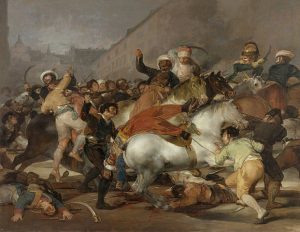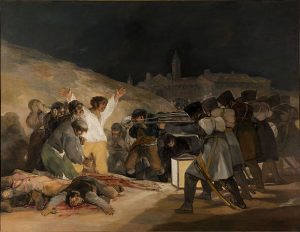And Speaking of Napoleon in Egypt…
While writing my last blog post I was stunned to realize that I’ve never written about Napoleon’s invasion of Europe here on the Margins. I've hinted around the edges of the subject in posts on the Rosetta Stone and Tipu Sultan. But I’ve never written about the invasion itself. Which is kind of amazing given that the image on the header of History in the Margins (and on my website and on my business cards) is from Jean-Léon Gérôme’s Bonaparte Before the Sphinx (1886)--a painting that I think is a brilliant illustration of the complex relationship between Europe and the rest of the world during the long eighteenth century.
Here goes:
In December, 1797, France was poised to invade England. The revolutionary French Republic had made peace with Spain, Russia and Holland.* General Bonaparte was negotiating with Austria. Russia had not yet declared war. Only England and Portugal stood armed against France.
In February, after inspecting preparations for the invasion, Bonaparte wrote to the five-man committee who governed revolutionary France (hereafter referred to as the Directoire) and proposed France invade Egypt instead. He argued that the military and financial resources available for invading England were utterly inadequate.** The best way to attack England was through the East. The conquest of Egypt would not only weaken the Ottoman Empire, but would cut England's access to India, thereby weakening Britain.*** The Directoire agreed.
The Egyptian campaign was a military disaster. (When Napoleon failed, he failed on the grand scale. )
The Army of the Orient sailed for Egypt on May 19, 1798. After capturing Malta, the French landed on the beach at Marabut**** on July 1. Without issuing supplies or giving his men time to recover from a grueling sea voyage, Bonaparte marched them across the Libyan Desert. They attacked first Alexandria and then Cairo. Both cities fell quickly. Always a master of the political spin, Bonaparte reported glorious victories to the Director. He left out the fact that French morale was low. One officer wrote home “…it was thirst which inspired our troops in the capture of Alexandria. At the point the army had reached, we had no choice between finding water and perishing.”
The morale of the conquering army would sink further. On August 1, 1798, Admiral Horatio Nelson annihilated the French fleet at Abukir By. He left behind a squadron of three battleships and three frigates to patrol the coast from Damietta to Alexandria, effectively cutting off all communication between the Army of the Orient and France.
Stranded with no news or supplies from France and an empty treasury, Bonaparte chose to lead with his chin. He moved the war into Syria, leading 13,000 men against the Ottoman Empire. He only got was far as Acre before he was turned back by a combined force of British and Ottoman troops. Bonaparte camouflaged the humiliation of the retreat in his reports to the Director with the news of a stunning victory against the Ottomans at Abukir.
Bonaparte slipped away from Egypt on August 18, 1799, without notice to either his staff or his successor. He reached France only a few days after the news of his victory at Adukis, in time to seize power in the coup of November, 1799. He left behind a deficit of twelve million francs and an occupying army demoralized by devastating losses, illness, and lack of supplies.
So much for following Alexander’s path to the east.
*That wouldn't last.
** Check your atlas if you don't have the relative positions of England and Egypt in relation to France firmly in your head. Then try to follow the reasoning.
***He did not mention his personal dream of following in Alexander the Great's footsteps and conquering India.
****An islet down the coast from Alexandria. You might as well keep your atlas out if you are map-minded.
Word With A Past: Guerrilla Warfare
Guerrilla tactics are probably as ancient as war itself. The word itself dates from the Napoleonic wars, a product of the Peninsular War of 1808-14 in Spain—the most prolonged and, with the exception of Napoleon’s invasion of Russia, most destructive campaign of the period.
Napoleon’s invasion of Spain had its official roots in long-simmering tensions between King Carlos IV of Spain and his son Ferdinand. (Though it’s hard to believe that Napoleon wouldn’t have invaded eventually even without an excuse.) Fearful that his father intended to remove him from the succession, Ferdinand asked for help from Napoleon in deposing his father.*
Carlos IV and his wife were not popular with their subjects. In March 1808, a popular uprising forced Carlos to abdicate in favor of Ferdinand. The new king arrived in Madrid on March 24, one day after the French commander Joachim Murat entered the city at the head of the French army. Popular feeling against Carlos IV’s corrupt government was so strong that many Spaniards greeted the French as liberators.
By the end of April, it was clear that the French had come to conquer Spain, not to liberate it. Both Carlos and Ferdinand, held captive in the French city of Bayonne, abdicated. By the time Napoleon named his brother Joseph the king of Spain on May 10, the country had already risen in rebellion.
- Francico Goya. The Second of May
- Francisco Goya. The Thrid of May
On May 2, rumors began to spread that the French planned to forcibly remove the remaining members of the royal family to Bayonne. Violent protests erupted in Madrid. A Mamluke cavalry unit, a souvenir of Napoleon’s invasion of Egypt,** charged the protesting crowd, which was armed with little more than cudgels and knives.*** Once the protestors were dispersed, Murat’s men rounded up everyone they could find who was armed. Executions lasted through the night and well into the morning.
The brutal repression of the May 2 protest fueled Spanish resistance. For six years, Spanish patriots, men and women alike, fought against the French occupiers in small irregular bands and provided critical support to the British Army in the Peninsular War against France. They were termed guerrillas—a diminutive of the Spanish word for war, guerra.
Guerrilla warfare: a little war, often pursued with big aims.
*This should be filed in the Big History Binder labeled "what were they thinking???"
**More useful than a t-shirt or a scale-model of the Pyramids.
***Unfortunately, variations on this show up more in history with some regularity. And not just in the distant past. Or in other countries.
Shoot Like A Girl Is A Compliment
As anyone who's been hanging out here in the Margins knows, I'm working on a global history of women warriors. I'm looking at examples from across the globe, from the ancient world through the twentieth century. Looking at their stories in the context of women in the modern American military--or maybe looking at women in the modern American military in the context of their stories--is an important part of what I'm doing.*
Shoot Like A Girl: One Woman's Dramatic Fight in Afghanistan and On the Home Front tells an important modern story. 
In 2012, former Air National Guard pilot and Purple Heart recipient Mary Jennings Hegar joined forces with the ACLU to successfully challenge the ban that kept American women out of ground combat units. In Shoot Like A Girl, Hegar tells the story of the career that led her to that point.
Hegar's love for flying, her commitment to her job, and her bonds with teammates are vivid on every page. The incident for which she received the Purple Heart--when her helicopter was shot down in Afghanistan with wounded men aboard—is a gripping story, told with skill. But the heart of the book is the institutional and individual sexism that Hegar had to overcome at every stage of her career.
Writing in a matter-of-fact, conversational style, Hegar recounts acts of casual prejudice that will feel familiar to any woman who has worked in a male-dominated field, hazing by hostile teammates and one horrifying instance of sexual assault by an army doctor during an exam, made worse by fact that his superiors took immediate action to protect him from punishment. Hegar shares feelings of betrayal, isolation, and anger. She admits to tears on more than one occasion. But her strongest response is a desire to prove that everyone who told her women shouldn't be military pilots was wrong. She succeeds.
Shoot Like a Girl made me cry, swear, laugh, cheer, and occasionally slam the book shut and walk away.
*"Why now?" is one of the questions you need to answer when you try to sell a non-fiction book to a publisher.
Most of this review previously appeared in Shelf Awareness for Readers.

